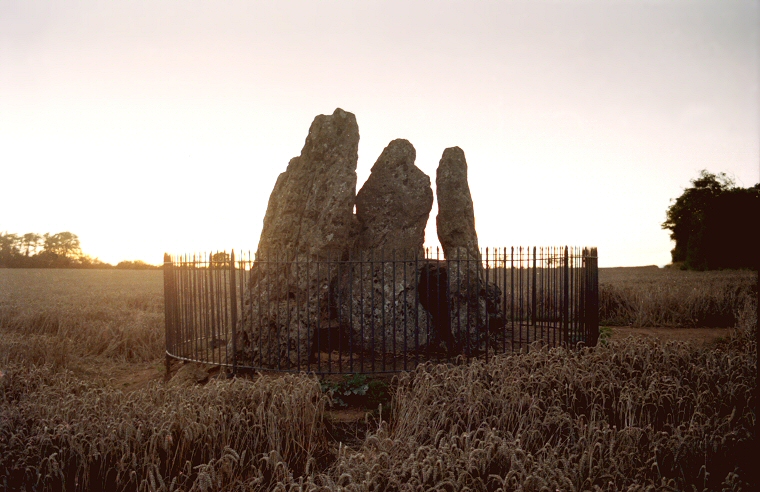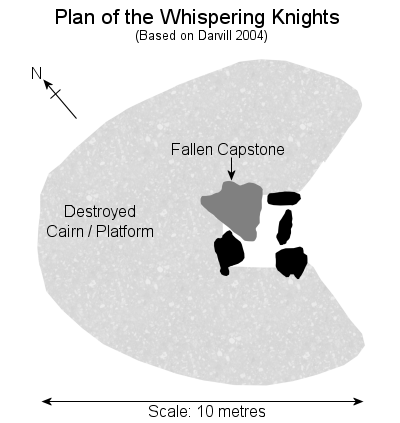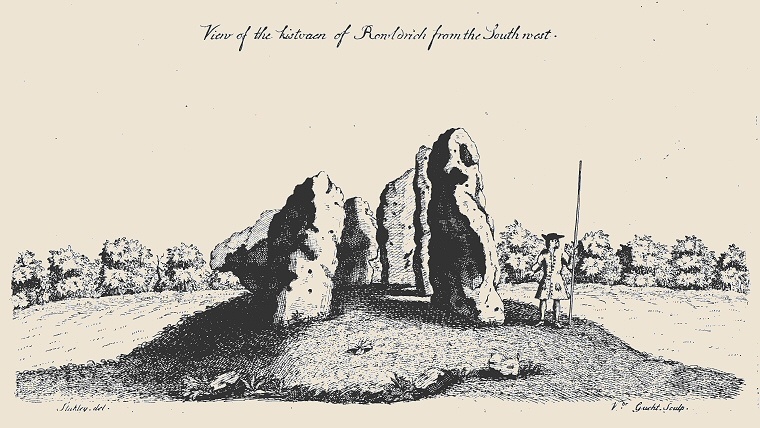
The Whispering Knights, view of the portal setting looking northwest at sunset.
The group of stones known as the Whispering Knights forms one constituent part of a collection of three prehistoric monuments often just referred to as the Rollright Stones, the other two being the famous King's Men stone circle and the King Stone standing stone. However it predates the other two monuments
by a wide margin being constructed during the early Neolithic, probably sometime between 4000-3500BC.
 Located in a farmer's field on the Oxford side of the Oxfordshire/Warwickshire border and about 350 metres to the east of the stone circle the Whispering Knights are in fact the remains of a portal dolman burial
chamber consisting of four remaining limestone uprights
standing between 1.5-2.4 metres tall and forming the sides of a box shaped structure measuring 1.8 metres square. A fifth slab that has collapsed partly into the chamber is believed to have been the capstone that the uprights would have supported.
Located in a farmer's field on the Oxford side of the Oxfordshire/Warwickshire border and about 350 metres to the east of the stone circle the Whispering Knights are in fact the remains of a portal dolman burial
chamber consisting of four remaining limestone uprights
standing between 1.5-2.4 metres tall and forming the sides of a box shaped structure measuring 1.8 metres square. A fifth slab that has collapsed partly into the chamber is believed to have been the capstone that the uprights would have supported.
The antiquarian William Stukeley visited Rollright (which he referred to as Rowlright or Rowldrich) in the mid 18th century and described the chamber as having five uprights and a fallen capstone at that time. However he could be mistaken and writing from memory as his illustration (shown below) is ambiguous, the stone in the left foreground could be partly concealing the capstone on the left and an upright on the right or more likely, they may in fact both be the same leaning capstone.
The stones of the chamber would have been surrounded on three sides by a low oval stone rubble cairn or platform, traces of which were found during excavations in 1983. The fourth side towards the southeast was left open allowing access to the tomb and forming a forecourt, perhaps for the periodic performance of rituals and ceremonies at significant times of the year involving the deposition or removal of human remains. The only find from within the chamber itself is an undated piece of human cheek bone recovered in the early 20th century.
The Whispering Knights were part of the King's retinue in the in the folk tale recounted on the King's Men page.
 Located in a farmer's field on the Oxford side of the Oxfordshire/Warwickshire border and about 350 metres to the east of the stone circle the Whispering Knights are in fact the remains of a portal dolman burial
chamber consisting of four remaining limestone uprights
standing between 1.5-2.4 metres tall and forming the sides of a box shaped structure measuring 1.8 metres square. A fifth slab that has collapsed partly into the chamber is believed to have been the capstone that the uprights would have supported.
Located in a farmer's field on the Oxford side of the Oxfordshire/Warwickshire border and about 350 metres to the east of the stone circle the Whispering Knights are in fact the remains of a portal dolman burial
chamber consisting of four remaining limestone uprights
standing between 1.5-2.4 metres tall and forming the sides of a box shaped structure measuring 1.8 metres square. A fifth slab that has collapsed partly into the chamber is believed to have been the capstone that the uprights would have supported.
The antiquarian William Stukeley visited Rollright (which he referred to as Rowlright or Rowldrich) in the mid 18th century and described the chamber as having five uprights and a fallen capstone at that time. However he could be mistaken and writing from memory as his illustration (shown below) is ambiguous, the stone in the left foreground could be partly concealing the capstone on the left and an upright on the right or more likely, they may in fact both be the same leaning capstone.
The stones of the chamber would have been surrounded on three sides by a low oval stone rubble cairn or platform, traces of which were found during excavations in 1983. The fourth side towards the southeast was left open allowing access to the tomb and forming a forecourt, perhaps for the periodic performance of rituals and ceremonies at significant times of the year involving the deposition or removal of human remains. The only find from within the chamber itself is an undated piece of human cheek bone recovered in the early 20th century.
The Whispering Knights were part of the King's retinue in the in the folk tale recounted on the King's Men page.

William Stukeley's sketch of the Whispering Knights from the mid 18th century.
Site Visits / Photographs:
June 1992, August 1997.
References:
Burl, A. 1976. The Stone Circles of the British Isles. London: Yale University Press.
Burl, A. 1995. A Guide to the Stone Circles of Britain, Ireland and Brittany. London: Yale University Press.
Camden, W. 1722. Britannia. Gibson Edition Vol 1. London.
Cope, J. 1998. The Modern Antiquarian. A Pre-Millennial Odyssey through Megalithic Britain. London: Thorsons.
Darvill, T. 2004. Long Barrows of the Cotswolds and surrounding areas. Stroud: Tempus Publishing Ltd.
Dyer, J. (Editor). 1993. Discovering Prehistoric England. Princes Risborough: Shire Publications Ltd.
Evans, A. 1895. The Rollright Stones and their Folklore. Folk-lore, Vol 6, 6-51.
Ferguson, J. 1872. Rude Stone Monuments in all Countries; their age and uses. London: Murray.
Lynch, F. 1997. Megalithic Tombs and Long Barrows in Britain. Princes Risborough: Shire Publications Ltd.
Plot, R. 1677. The Natural History of Oxfordshire. Oxford:
Stukeley, W. 1743. Abury, A Temple of the British Druids, with Some Others, Described. London
Historic England Research Records: Hob 968858.
NMR Number SP 23 SE 31
Pastscape Monument Number 332813 (Rollright Stones).